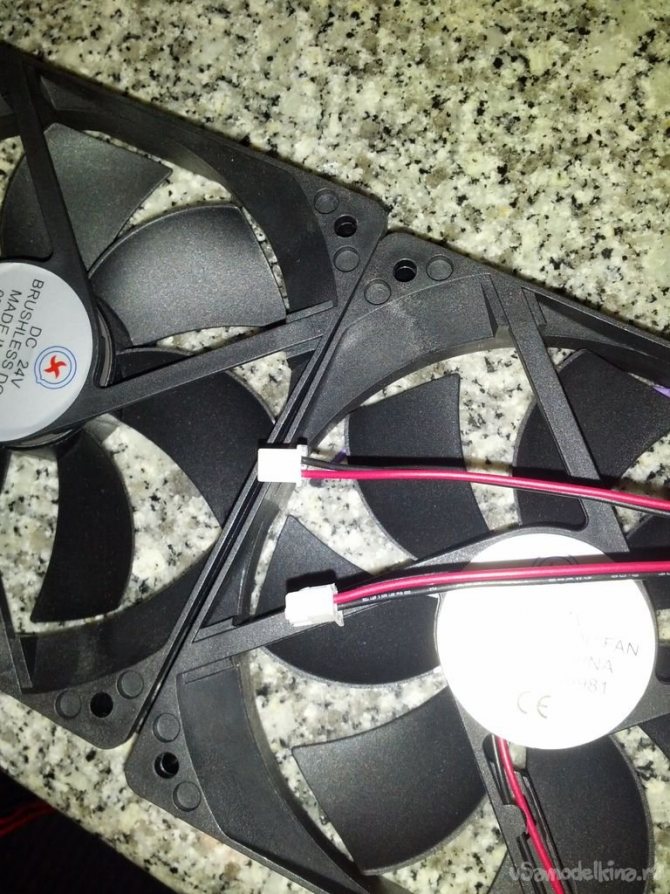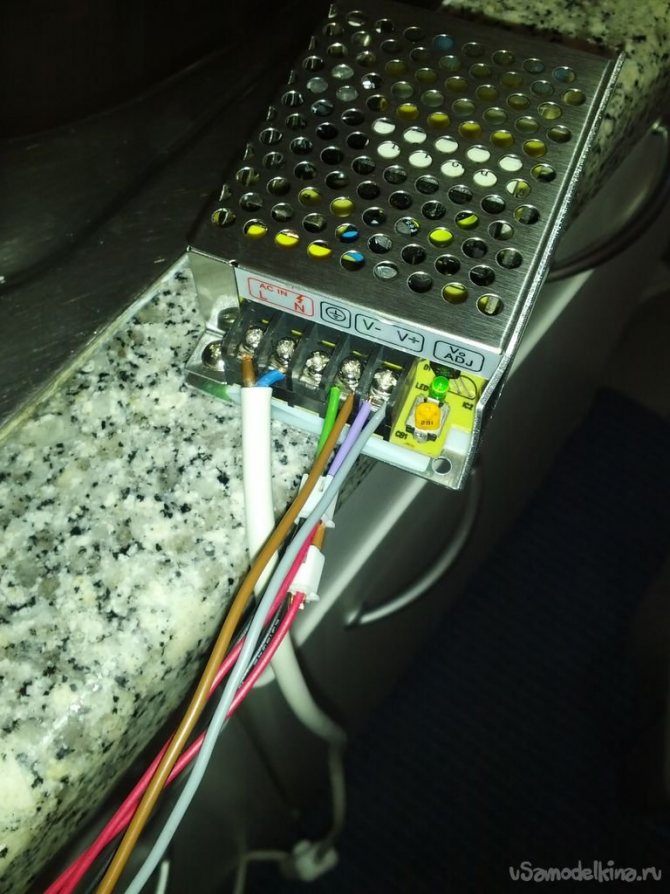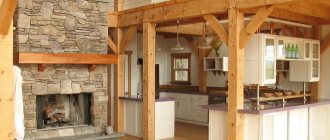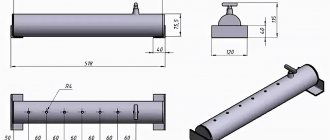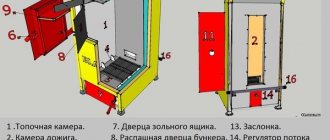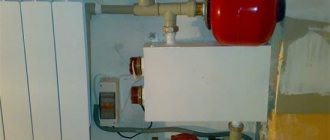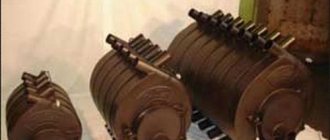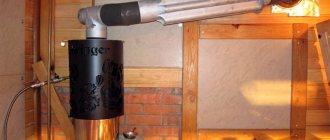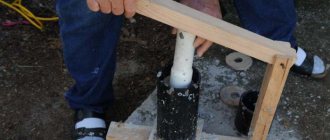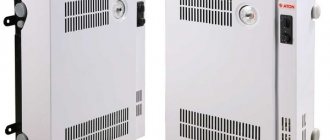Boiler structure feature
The requirements for boilers by owners of private houses are simple:
- He must be economical.
- Have a very high level of heat transfer.
- Not expensive.
Taking into account the fact that both gas boilers and the connection of a gas pipeline to a house cost a lot of money, and the subsequent payment for gas will also not bring savings, in many private houses devices that run on wood are installed. The most effective type of heaters is a water boiler, which can not only heat a small country house or summer cottage, but also supply it with hot water.
A home-made boiler made of cast iron batteries is an excellent alternative to industrial units that are expensive and save little.
Its structure is such that a water boiler is built into an ordinary stove, which increases its heat transfer many times, thereby reducing waste on firewood, and warming up the room almost instantly.
Preparatory work
Finding old Soviet cast iron batteries is not a problem today. Dozens of them are demolished when residents of apartment buildings change their heating to more modern models, or when old buildings are demolished. The best option for the manufacture of the structure will be cast-iron radiators M-140.
One battery section holds up to 1.5 liters of water. The number of sections directly depends on what area the heating boiler should heat from a cast-iron battery. For example, a house with an area of 100 m2 will require 12 sections with a total capacity of 18 liters and a size of 3 m2.
Before proceeding with the manufacture of the boiler, all sections of the radiator must be thoroughly rinsed from scale and dirt accumulated over many years of operation. To do this, you can pour inside a 6% hydrochloric acid solution and hold it there for a while until it eats away all deposits. After that, the solution is drained and each section is thoroughly rinsed with water.
This procedure should be carried out slowly, in compliance with all precautions. Protective gloves should be worn on the hands and a respirator on the face. After all the sections have gone through the cleaning process, you can begin to assemble the boiler from the cast-iron battery with your own hands.
Assembling the structure
It is not difficult to assemble radiators together, but first you should purchase new intersectional gaskets or use an asbestos cord impregnated with graphite powder previously diluted in drying oil instead.
Since the temperature inside the boiler can exceed +600 degrees, it is worth taking care of the gaskets in advance. The tightness of the entire structure depends on their quality and strength.
The sequence for assembling radiators is as follows:
- Nipples equipped with right-hand and left-hand threads are screwed into each section.
- Asbestos cords are wound around them.
- The sections are connected in pairs by alternately tightening the nipples. It is important to make the same number of turns with the wrench, so as not to cause distortion.
- All sections of the cast iron radiator are connected in the same way.
- The return and supply pipes should be connected diagonally, closing the unused openings with plugs.
There should be a right-hand thread on one side of the riser, and a left-hand thread on the other. If this does not work out, then you need to screw on the nipple, and on it a coupling with a drive.
Heat exchanger designs for heating furnaces
A feature of a heat exchanger for a heating stove, located in the firebox, is that its upper part is usually closed with a sheet metal shelf or pipes.Since the maximum temperature of the flame is in its upper part, thus, the most efficient heat intake and transfer of it to the coolant is achieved. Its design and dimensions must be such as to ensure maximum efficiency of the water circuit, but at the same time not interfere with the loading and normal combustion of the fuel. Such furnace boilers can be made of sheet metal 4-5 mm thick, round pipes with a diameter of 32-57 mm, or rectangular pipes 30-40x50-60 mm. It is best if the pipes used for this are seamless. Otherwise, the seam lines must be placed in the direction of the brickwork and pre-welded with welding.
Depending on the shape of the firebox overlap, such heat exchangers can be flat at the top (when covered with flat cast-iron plates) or arched (with an arched brick floor).
Below are the possible options for a heating stove with a flat firebox overlap:
Fig. 1 Heat exchanger for heating furnace made of 4-5 mm sheet steel.
In addition, an option with a combination of sheet metal and pipes is possible, as in the photo on the left. Here the top solid shelf is replaced by a row of round pipes. In this case, both in the first version and in the second, the "return" and the supply pipe can be welded from the side (on one side or from different sides) or from the back, depending on the location of the furnace and the layout of the water heating pipes.
It is also possible that the side walls of such a heat exchanger will also be replaced by pipes of a round or rectangular profile, while they can be located both vertically and horizontally.
For a heating stove with an arched firebox overlap, the following boiler option is possible from pipes:
This form of register can be used even for arranging a water circuit in a Russian stove. In this case, the curvature of the bend of the pipes must correspond to the arch of its cooking chamber.
Positioning the boiler in the furnace
It is important not only how the radiators will be assembled and connected to the heating system, but also their place in the stove. In order for the device to work for a long time and efficiently, the boiler from a cast-iron heating battery (the video shows how to do this) should be installed not in the firebox, where wood or coal is burning, which means there is an open fire, but behind it in the smoke channel.
This will save the device and extend its service life, and heating by gases that are formed during fuel combustion is no worse than an open fire.
Cast iron is a rather brittle metal, so it will not withstand shocks, unnecessary pressure, or too high a temperature. When installing the boiler from the radiator into the furnace, you need to make sure that the pipe at the exit from it was perpendicular to the floor, and the return flow passed under the floor and the foundation of the structure.
After the boiler is installed, you can start laying the walls of the stove, having previously checked it for leaks. To do this, you need to run water through the system under pressure.
Furnace masonry
The stove can be built independently, following the sequence of actions.
- The first is the laying of the foundation of the structure, made of reinforced concrete.
- For masonry, the best solution would be a mixture of two portions of sand and a portion of clay. To mix them better, experienced builders recommend soaking the materials in water and leaving them overnight. During this period, they will mix well without additional efforts on the part of the owner.
- When the foundation is ready, it should be covered with waterproofing, for which roofing material can be used.
- A layer of mortar is placed on top of the waterproofing, the uniformity of which is best checked with a plumb line.
- The first masonry should form a blower, over which a grate is installed, separating it from the firebox. The grill is attached after 2-3 masonry above the blower.
- In the process of forming the furnace, a place is immediately prepared for the boiler from cast-iron batteries, taking into account the gaps between it and the outer wall of the stove... To do this, a side of bricks is laid around the perimeter, on which the corners are attached. It is on them that the boiler will be installed.
- When laying the masonry, you need to take care of the places where the supply and return pipes will come out in advance.
- The next stage is laying the chimney. During this work, special channels are formed to discharge fumes and combustion waste through them.
After finishing laying the chimney, the entire stove must be checked for the quality of work, for which it is flooded.
It is never necessary to heat the stove if there is no heating medium in the boiler. This could damage the system. You can think over and build a structure that will work both as a heating system and as a stove for cooking.
After completing all the steps step by step, it is quite possible to build a furnace with a water boiler from cast iron batteries with your own hands.
Sooner or later, it may turn out that even a cast-iron battery will require a complete replacement or you will just need to clean it. In both cases, the battery will have to be disassembled. How to disassemble a cast-iron heating battery with your own hands quickly enough and as professionally as possible? The fact is that such radiators are the best option for use in apartment buildings. These heating elements are able to withstand all the vicissitudes of an imperfect heating system. Sometimes, over time, even the cast iron has to be changed, because it has leaked or simply does not fit into the new apartment renovation.
The most frequent breakdowns, their signs
Yes, cast iron is an extremely resistant material and is ideal for central heating. In such systems, there are also wide channels that do not allow dirt to accumulate so quickly inside pipes and radiators. But even in this kind of radiators, there are always problems.

Although metal does not know what wear is, as many say, it does not last forever. One of the reasons for the formation of cracks can be a fistula. It is formed precisely on the walls of the radiator or else in the place of the gap. This is influenced by the following number of factors:
- Absolutely everyone knows perfectly well that cast iron radiators are very heavy. And if, during installation, ordinary brackets are used for the battery, then soon the structure will sag strongly or completely fall. And even the slightest deviations from the set position will easily ruin the entire heating process. If you have a deviation of the radiator and you have not done anything, then later corrosion will actively develop in it. At first, corrosion will be completely invisible, but soon it will grow and form a fistula in its place. Although both new and old types of cast-iron batteries are distinguished by their survivability, in the presence of a fistula, their service life will drop sharply.
- Consider the old type of radiators. Due to the fact that this type has roughness inside, over time, dirt can begin to accumulate, which is quite a lot in our water. Absolutely everything, lime, small particles settle on this surface and every day makes the passage narrower and narrower. It is because of this that the pressure inside the radiator will increase. Everything can lead to the fact that the radiator will simply rupture and then you will definitely have to change it to a new one. Repair will not help here in any way.
- Nipple thread, gaskets. These are the things that are the weakest point. And if the cast iron itself can live for many years, then the gaskets will obviously change often. And in order not to wait for the most critical moment, it is worth taking care of them and periodically updating the nipples and gaskets.
As practice shows, the bulk of problems with cast iron batteries appear when it is time for repairs. And in order to be prepared in advance for all problems, it is best to know all the signs of breakdowns. This will help a lot before starting renovation work.
Preparatory work
Before proceeding with the replacement or repair of a cast iron radiator, it is necessary to take care not only of the availability of all the tools, but also of the spare parts that may be needed. (See also: Diagram for installing heating radiators with your own hands)
If you decide to completely replace the cast-iron radiator with a similar, only modern model, during the preparatory work it will be advisable to install the brackets on which the battery will subsequently be held.
Water must be shut off and drained before replacement or repair. The following tool is required for dismantling.
Rust removal brush with metal bristles.
Gaskets and tow.
Dismantling the cast iron battery
At first glance, disassembling a cast-iron battery with your own hands is quite simple, but it is not. So, first you need to heat the plugs on the battery, for this I use a blowtorch. After the plugs have heated up, they can be unscrewed much easier than without heating. (See also: Cast iron heating radiators)
With the help of a grinder, the battery is cut very carefully between the sections. After cutting, the radiator sections are disconnected. In cast iron batteries there is a nipple that must be carefully knocked out of the battery using a chisel. This is required if you decide to clean the radiator or replace a separate section. With a complete replacement of the radiator, it is naturally not necessary to clean anything. It is enough to cut it with a grinder and take it out.
The nipple must be removed so that the thread is not damaged. It is subsequently thoroughly cleaned of rust. Further, the grouping and collection of individual sections is carried out. In order for the battery to have good tightness between the sections, you need to install gaskets and coat all joints with silicone. A little later, when everything is dry, the battery can be gently rinsed using a hose.
Repair of copper heat exchangers
During the operation of evaporators, different types of damage appear: • breaks in pipes at the point of water supply and its outlet; • violation of integrity as a result of water hammer; • dents, fistulas; • violation of the tightness of threaded connections.
Before starting the repair, a search is performed for microcracks that are not visually noticeable. Hidden defects can only be detected by crimping. The fistulas are removed by brazing the copper heat exchanger using high temperature solders.
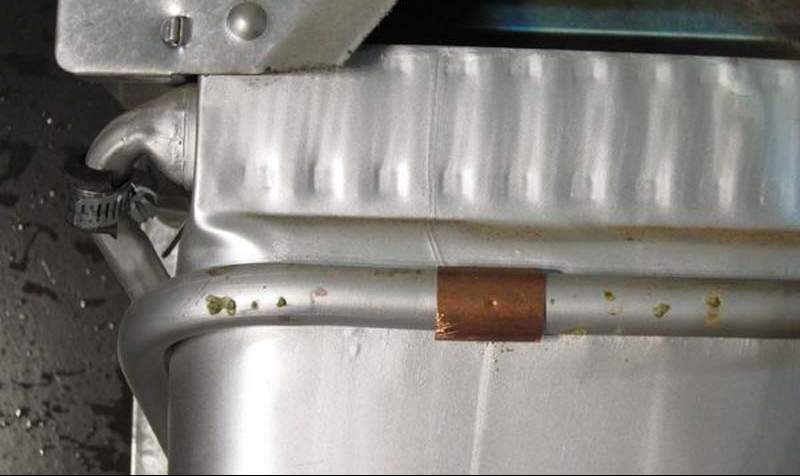

For work you need a soldering iron, flux and solder. First, a flux is applied, which cleans the surface of oxidized particles. It also helps to distribute the solder evenly. A paste that contains copper is used as a flux. If it is not there, then you can take rosin and even an aspirin tablet.
The note! When welding a copper heat exchanger, it is necessary that the solder melts from the tube, and not from contact with the soldering iron.
The layer of solder in the place of damage builds up gradually until its thickness reaches 1-2 mm. The burner flame must be medium, otherwise the evaporator can be damaged further. After the end of the soldering, you need to remove the remaining flux. Because the acid it contains corrodes copper.
Installing a new cast iron battery
Installation is more difficult than dismantling a battery. It is quite possible to do these works yourself. The main thing is to adhere to the rules and follow certain requirements. When installing the battery, be sure to keep its position strictly vertical. Check with a plumb line or level. Otherwise, there is a chance to deal with dismantling again and such a problem as fixing a cast-iron battery. (See also: Which panel radiators are better)
If you have to install several cast-iron batteries in a room, keep in mind that they should all be on only one level.That is why, before attaching the brackets that will hold such a heavy structure, it is better to make markings for future holes. This is done using a special template.
As a material for the template, you can use thin plywood, a little larger than the battery itself. On the sample, in the place where the brackets will be located, holes must be drilled. The calculation of the required number of brackets can be performed according to the simple formula 1 bracket per 1 m2 of heating surface. When installing the drilling template, it must be installed using a plumb line.
In place of the marks, holes are drilled using a drill or puncher. The diameter of the holes must be such that the brackets can go inside the wall by at least 12 cm. After the brackets are inserted into the wall, they must be fixed with ordinary cement mortar. You can hang a cast-iron battery on the brackets only after the solution has completely dried. (See also: DIY installation of heating batteries)
Such requirements for securing the brackets must be met. After all, the weight of the edge of a cast-iron battery is about 7 kilograms, and this is still without water. Imagine the weight of an entire structure filled with water.
And the last step is only to connect the radiator to the general heating system. Before this, the plugs are opened. All joints at the joints must be laid with tow or fum tape in order to exclude leaks. In order for the battery to be filled with water, a special tap is opened.
We make a convector out of an ordinary battery
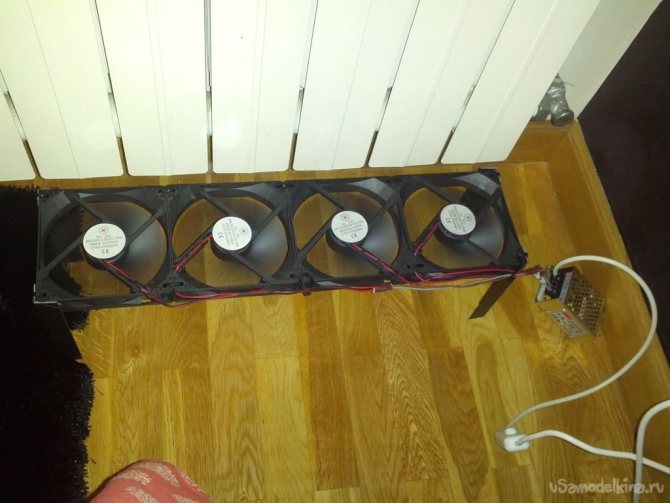

Radiators for hot water heating, or simply batteries used in centralized heating systems, distribute heat through rooms according to the principle of passive convection. This approach is not very rational in terms of heat loss, especially if the battery is in the corner of the room.
For this reason, there are convection radiators equipped with a fan, which improves heat distribution throughout the room, accelerating the circulation of air between the battery sections.
In this master class, I will show you how to pump a conventional battery to a convector battery with your own hands.
Step 1: Assembling the fans


I took 4 fans Brushless DC Cooling Fan 7 Blade 24V 120mmx120mx25mm
.
This type of fan is very quiet and fits well with my battery. A connection of 4 such fans will be enough for my pipe in length.
Fan characteristics: - 7 plastic blades - speed 1600 rpm - air flow 58 cc. ft / min - noise 38 dB. - power supply: DC 24V, 0.20A
These fans cost me 1200 rubles with delivery. Structural strength is provided by cable ties that pass through the holes in the corner of each fan and tie them together.
Step 2: Connect the wires
The fans use standard 2-pin connectors like motherboards. They hold copper cables well. You can also connect the 2 connectors with a small piece of cable by inserting one into the back of the other.
This will help reduce the number of cables connecting the fans to the power supply. The power supply is connected by a 2-wire AC cable on one side and DC cables from the fans on the other.
The photo does not show the switch and the standard plug at the end of the AC cable. I took the power supply unit like this - 24V Universal Regulated Switching 25W Power Supply
.
Step 3: Checking the fan operation
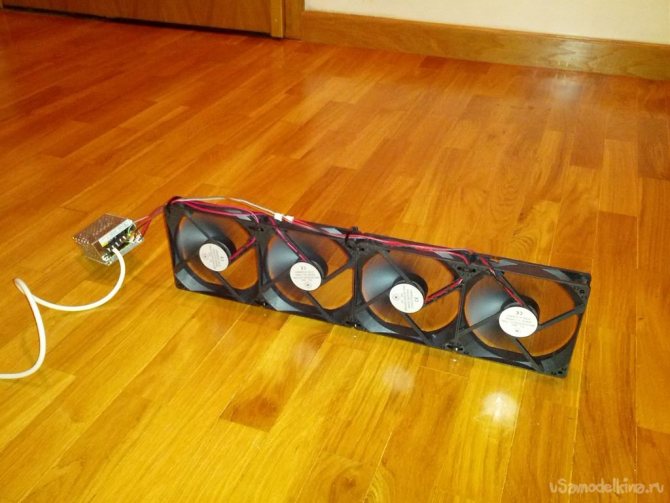

I connected the fans and tested them before installing them under the battery.
Step 4: legs and other tweaks


I fitted my fans with 4 legs from a corner cut into 15cm pieces. Then I just put a section under the battery.As a result, I got excellent heat distribution throughout the room, using almost silent fans consuming a total of 24 watts:
- fans: 4 * 0.2A * 24V = 19.2 W - power consumption: 80% of the total supply - total power: 19.2 / 80% = 24W
This is how I pumped my standard hot water heater to a convection radiator.
Become an author of the site, publish your own articles, descriptions of homemade products with payment per text. More details here.
How to calculate the number of sections
In order to correctly calculate the required number of sections in the battery, you need to know that the thermal indicator in such radiators varies from 80 to 160 W. a few years ago, the calculation of capacity was carried out according to the principle - one section per 2 square meters. Now the calculations are more complicated. But this makes it possible not to overpay extra money and get an optimal thermal result.
In order to correctly calculate the power, a coefficient is required, which is 41 W for block houses and 34 W for high-rise buildings made of bricks, but for modern new buildings in which only modern materials are used as insulation, this coefficient is only 20 W.
An important point, all these coefficients are provided only for rooms in which there are installed double-glazed windows. If you have wooden windows in your apartment, then you need to add 15% to the value.
The power of the device will be equal to the volume of the room multiplied by a factor. In order to find out the number of sections, you just need to divide the result obtained by the thermal power of one section.
Of course, it is better to buy sections with a margin. For example, you have 20 sections, you'd better buy 21. The power of a cast-iron radiator is calculated in a similar way.
I would like to add that today cast iron radiators are still very relevant. There are many types of a wide variety of manufacturers on the market. Czech cast iron batteries have proven themselves quite well. There are quite original designed models.
If you choose among domestic manufacturers, then you can note the Luhansk cast-iron batteries. They have proven themselves well in the consumer market, and have also received many positive reviews.
If you decide to swap out your old cast iron batteries for new lightweight radiators, think carefully. Will it turn out that in winter you will feel somewhat cool in the room? If the main reason for changing heating elements is the appearance of the batteries, then it may just be worth updating them.
How many kilowatts in one section of a bimetallic radiator
In appearance, bimetallic radiators are difficult to distinguish from aluminum ones. They can also be equipped with air cutters, and the level of heat dissipation mainly depends on the height.
As is the case with aluminum, the data in the manufacturer's specifications differ from the real ones. Accordingly, in order to unequivocally answer the question of how many kW in 1 section of a bimetallic radiator, you need to know all the conditions. Therefore, we provide information for the water temperature in the circuit 65-70 degrees.
Thermal output of a section of a bimetallic heating radiator without air cutters:
- 200 mm - 0.5-0.6 kW;
- 350 mm - 0.1-0.11 kW;
- 500 mm - 0.14-0.155 kW.
How many kW of one section of a bimetallic radiator with air cutoffs:
- 200 mm - 0.6-0.7 kW;
- 350 mm - 0.115-0.125 kW;
- 500 mm - 0.17-0.19 kW.
Useful Tips
Interesting fact. Many people do not want to use cast iron radiators solely because of their appearance. But recently, it is the cast-iron retro heating batteries that have become widespread. These are the models that they so diligently left. Fans of retro style often specially order such models in stores. Admirers of more modern design can be offered to decorate cast-iron radiators with special screens.
There is no heat loss from the screens, but the batteries look somehow very simple, but stylish. Those who do not want to change their batteries can simply bring them back to their original beautiful appearance. Batteries can be repainted using modern materials or you can give them a rather unusual look yourself. When choosing materials, be sure to select those that can withstand high temperatures over 80 degrees. It is advisable to consult with sellers about painting materials. There are some paints that can change color when interacting with hot surfaces. In this case, having carefully painted the battery in a snow-white color, you can see a completely non-crystal white version during the heating period.
By the way, there are companies where you can order radiators designed to match the design of your room. This service is still just an innovation on the market. But it is starting to gain momentum. As practice shows, most users of cast iron radiators still prefer to modernize them rather than change them.
As the famous saying goes: "Prepare your cart in winter, and sledges and radiators in summer." Sooner or later, everyone faces the need to change batteries, and, of course, this should be done during the inter-heating season.
Before we proceed with the detailed step-by-step instructions for installing heating radiators with our own hands, let's dwell on the technical characteristics of the main types. After all, the installation process largely depends on the design features. Therefore, it is necessary to choose the right radiator, based on the area of the room, the operational properties of the heating system, SNiPs, norms and regulations for installation, etc.
Gas water heater with copper heat exchanger
The gas column contains a heat exchanger, in which water is heated by a burner. Copper with a high heat transfer coefficient quickly transfers heat to the water, which is used for taking a bath. The less impurities in the alloy are, the better, copper products work. If they are present, the walls of the container heat up unevenly, which causes them to burn out quickly. Sometimes, in order to lower the price of a copper heat exchanger, the wall thickness and tube diameter are reduced. The weight of the empty apparatus is up to 3.5 kg.
The heat exchange unit is manufactured in the form of a tube. In the lower part, it has the shape of a snake with ribs. A metal sheet is installed around it, and on top of it is a spiral pipe. In addition to copper, galvanized and stainless steel is used. Which heat exchanger is better, copper or stainless steel, says the very fact of the cost of the device. Copper is 20 times more expensive than steel alloy. But it transfers heat better and is more economical in operation. Stainless steel is more durable.


Important! Before buying a gas water heater with a copper heat exchanger, you should study its technical parameters. A good thing won't come cheap. Copper oxidizes strongly upon contact with water. This process is especially observed in the place where cold water is supplied. Condensation forms there. High humidity eats away at the tube wall and fistulas appear. They form quickly on thin walls. Quality goods will last the due time.
Types of radiators:
- Cast iron.
- Steel.
- Aluminum.
- Bimetallic.
Cast iron radiators
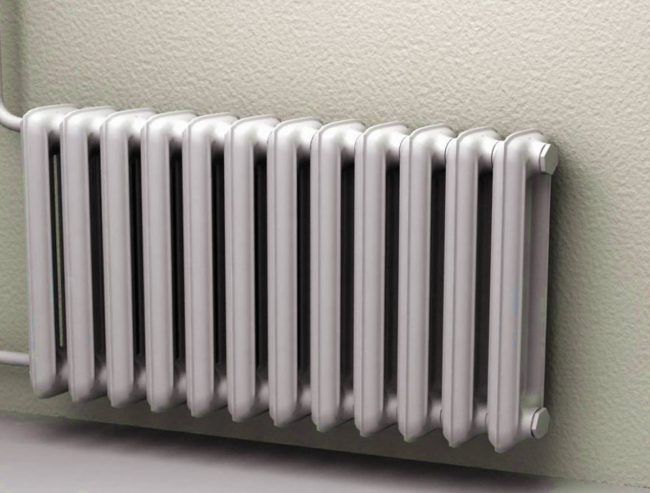

Heating radiator installed in the apartment
Cast iron radiators, perhaps, are the real "long-livers" on the market. A few decades ago, such batteries were in almost every house and apartment. But even today, despite technical progress and the emergence of newer modern radiators, cast iron products are very popular among our compatriots. Why are they so good?
It should be noted right away that today these heating systems have been significantly modified and technically improved.Therefore, speaking about the advantages and disadvantages, we will focus on those radiators that are currently on the market. One of the main advantages of these batteries is their long service life. Manufacturers give a guarantee of at least 50 years, but with proper care, this period can be doubled or even tripled. Of course, during this time, the aesthetic appearance of the heating radiator may become morally obsolete, but there is a purely technical possibility of operation for such a long time!
Due to the massiveness and high heat capacity of cast iron, these radiators are able to maintain a high temperature for a long time after turning off the coolant. They are quite resistant to pressure drops and aggressive environments. But due to its massiveness and heavy weight, the installation of cast iron batteries is a rather long and laborious process. In addition, they are not very beautiful in appearance, unless, of course, the cast-iron structure is a "highlight" of the style concept of the interior.
Steel radiators
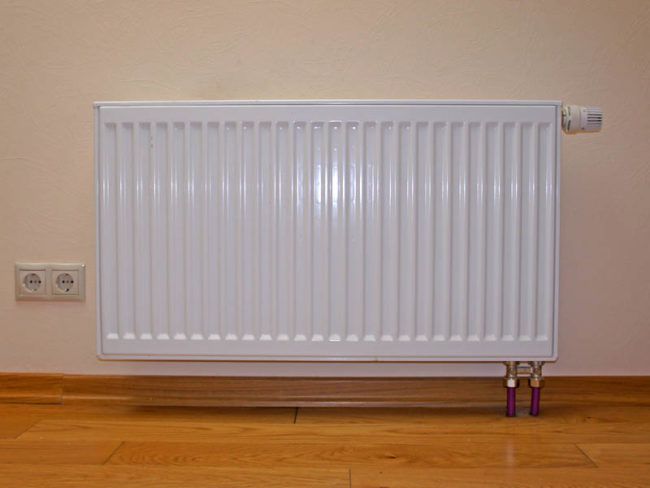

Steel radiator in the apartment - photo
These products belong to new generation batteries and are of two types: panel tubular.
Steel radiators are distinguished by high heat transfer, increased energy saving, and high efficiency. The structure consists of two steel plates welded together. These products are manufactured with two types of connection: side and bottom. The choice depends on the initial position of the heating circuit. Their high popularity in the market is due to their light weight, ease of installation and attractive appearance. When buying, be sure to carefully study the coverage, as this affects further operation.
Tubular radiators are a structure consisting of several sections, fastened together by welding. Depending on the area of the room and the heating effect, it is necessary to calculate the output of the finished module and select the optimal size. Tubular steel batteries are characterized by excellent heat transfer, high level of performance and low price.
One of the advantages of these radiators is also their most important disadvantage, if you turn off the heating system - steel radiators very quickly lose their heat and vice versa "help" the ambient temperature to cool the temperature of the liquid in the system. If cast iron radiators are warm for a few more hours, then their steel counterparts will become cold in 15-20 minutes.
Aluminum radiators
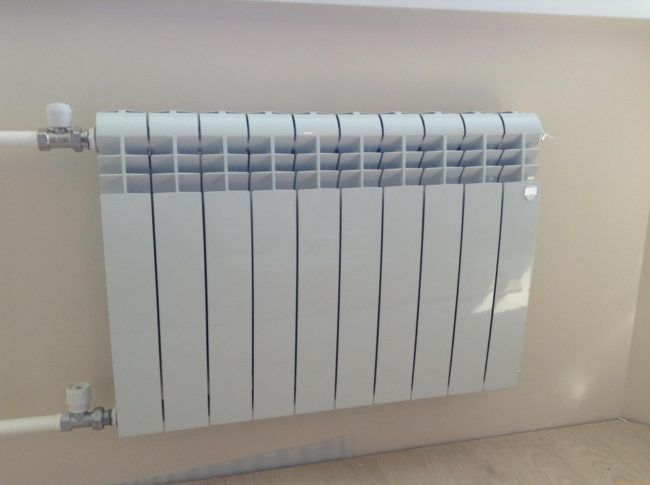

10-section aluminum battery
They are made of aluminum alloy and painted with powder enamel. Due to their high heat transfer capacity, such batteries quickly and efficiently warm up the room. Smooth, aesthetically pleasing and lightweight. They are very popular in the market today, but they also have a number of disadvantages.
The connection of individual sections is made using a threaded coupling method, which allows for a fairly quick installation of the battery. High tightness of aluminum batteries is achieved through the casting method. Each section is molded in a separate mold, after which it is combined into one overall structure.
Due to the chemical properties of the metal, aluminum radiators are not able to withstand the high pressure that is often created in central heating systems. Therefore, for installation in an apartment with a central heating system, it is better not to use these thin batteries. They are more suitable for a private house with an independently adjustable water pressure level in the system.
Bimetallic radiators
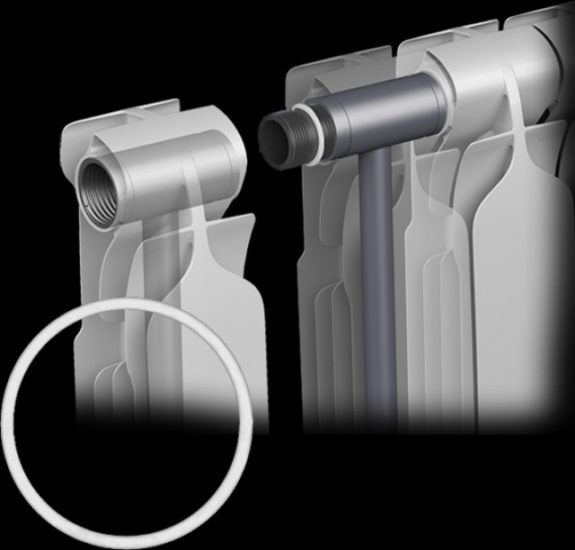

Bimetallic radiator device
These products today occupy one of the leading positions in the market. Made from high quality alloys, they feature a double construction.The outer layer of the panel is made of aluminum, which provides lightness, great appearance and high heat transfer. And the core of the structure is made of an alloy of metals that are resistant to corrosion and high pressure drops.
Thus, bimetallic batteries combine the best technical solutions from steel and aluminum radiators. The only drawback of these products is their high cost, which, however, is justified by the duration of operation and an excellent energy-saving factor.
High technical properties and attractive appearance make it possible to use them as an easily controlled and efficient heating system for an apartment.
Another indisputable advantage is the ability to independently determine the number of sections. Based on your needs, the area of the room and the required volume of heated air, you can personally assemble a radiator consisting of at least three or even thirty-three sections, which, of course, is not available when choosing cast iron or aluminum counterparts.
Using radiators
Heat transfer selection
So that the radiators do their job, i.e. provided a comfortable microclimate, we need to purchase a sufficient number of such devices for one room.
And here you can not do without calculations, the instructions for which are given below:


The number of heating points must correspond to the volume of the room
- The power consumption depends on how much volume needs to be heated. Therefore, we need to multiply the area of the room by its height (in meters). So, for a room with an area of 25 m 2 with ceilings of 3 m, the required value will be 75 m 3.
- Further, the volume is multiplied by the standard indicator of 41 W / m 3. This value determines the heat consumption per cubic meter of living space for central Russia. In our case, the total heat volume will be 75 * 41 = 3075 W.
For cast iron models, heat transfer is calculated per section
System installation
Do-it-yourself installation of radiators for heating is a rather complicated process, but this task is still feasible for most craftsmen.
Let's start the description of the algorithms with the instructions for installing electrical models:
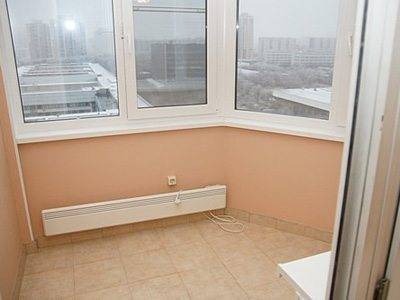

Electric radiator under the windowsill
As a rule, stationary electric heaters are mounted on the wall. In this case, for connection, either a socket located in the immediate vicinity of the device is used, or hidden wiring for a fixed connection.
- In order for heat flows to be evenly distributed in the room, the battery must be placed according to certain rules. It is extremely important to observe the size of the gaps: from the floor - about 100 mm, from the window sill - 80 - 100 mm, from the wall to the back surface of the battery - 30 - 60 mm.
- If the radiator is completely covered by a window sill, then it is advisable to make holes in it for the outlet of warm air, covered with plastic grilles. Otherwise, the bottom of the window pane will continually accumulate condensation as the coldest area in the room.
- The installation of an electric radiator itself is not difficult. It is enough for us to install the mounting brackets on the wall and hang the battery on them.
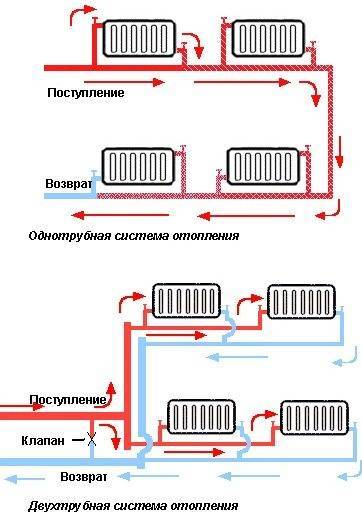

Water heating systems
With water heating it is much more difficult:
First, you need to choose a connection scheme. It depends on how efficiently the heat redistribution will take place. Possible schemes are presented in the images in our article, therefore, during installation, it is imperative to keep this information in mind.


Connection diagrams and heat loss during their implementation
- Secondly, we need to lay heating pipes. As a rule, steel or polymer products with good heat resistance are used for this purpose.
- After that, we carry out the installation of the radiator itself on wall or floor brackets.The heaviest are cast iron batteries, therefore the most powerful fasteners are used to secure them.
- Finally, you need to attach the radiator to the pipes. Most often, threaded connections are used here, which must be as reliable and tight as possible.
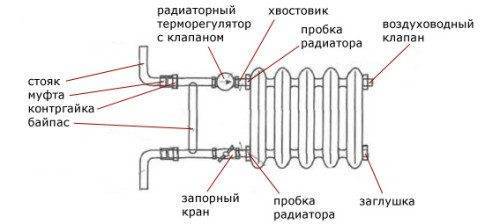

Fittings for connection
After completing the installation work, it is worth testing the system
If you have not done this, then it is important to follow the announcements of the beginning of the heating season: only the first launch of a test portion of the coolant will finally demonstrate how high-quality the installation was.
Calculation of the required number of sections


Table for calculating the number of battery sections.
After you have decided on the choice of a radiator, you need to correctly calculate its size. After all, even the most efficient radiator will not provide warmth in a room if its dimensions are not capable of heating the room.
The basic value for calculating the size of the radiator and the number of sections is the area of the room. We offer a simplified (everyday) option for calculating the number of radiator sections.
As a standard, to provide the necessary heat in the room, 100 W is enough per 1 square meter of area. We calculate in a simple mathematical way:
Q is the required heat transfer from the radiator.
S is the area of the room.
This formula will tell you what power of the radiator to take to heat the room if the radiator is a one-piece non-separable structure. If its scheme involves building up additional sections, then add one more parameter to these calculations:
N is the required number of radiator sections.
Qs - specific thermal power of one section.
To make the calculations correctly, you do not need a higher technical education. It is enough to pick up a tape measure and measure the area of the room.
Pay attention, this formula is suitable for a standard apartment with a ceiling height of 2.7 meters, if the height of your ceilings is much higher - we recommend doubling the required number of sections!
Where are we going to post?
Typically, radiators are placed where the greatest heat loss in the apartment is expected. As a rule, this is a zone under window or from the side of the corner wall of the house. Even if the apartment is located in a well-insulated building and is equipped with double-glazed windows, the window is the place where the lowest air temperature will be during the cold season.


Choosing the best place for the radiator
If you do not put the radiator under the window, then the cold air entering from the outside will gradually sink down and spread along the floor. We know from physics lessons that warm air moves upward. This means that, moving away from the battery and rising to the ceiling, it will create a kind of barrier for the cold stream from the street. According to the SNiP recommendations, the size of the battery should occupy at least 70% of the window, otherwise the warm air will not create the necessary barrier.
If the batteries are too short, a situation may occur where cold zones will form on the sides. As a result, the room temperature will be low even with a powerful radiator. As you can see, not always only the power of the battery provides a comfortable microclimate in the apartment.
Principle of operation
People who have equipped their own workshops, garages, houses, put exactly the stove stoves. It is a device that first appeared in the 1917 revolution. It was named because of the high consumption of fuel for the firebox, but a plus in the unpretentiousness of the stove.
A potbelly stove made of disks wins in design, it is simple, and also has a low price.
The main disadvantages are low efficiency - only 15-20%. Insufficiently thick metal walls conduct heat poorly; during processing, the device quickly cools. This happens because the bulk of the heat produced by the stove escapes into the chimney - that is, heats the street.


Heat exchanger
To increase the efficiency, you can try to increase the area of the heat-conducting surface. For this purpose, a heat exchanger is needed. It is mounted in a place where heat is concentrated to a greater extent, significantly increasing the efficiency.
The heat exchanger for the building is a device for indirect heating of water. The essence of functioning is that the fluid circulates in an enclosed space due to the convention. Water is heated under the influence of heat.
Hot layers rise, and colder ones take their place. Mixing water against the background of exposure to heat is called circulation. The heated water or other heat carrier, as it rises, transfers heat to the water. The stove becomes a heat exchanger as it creates heat.


The work of a potbelly stove in his house
The main functions of the device are:
- The heat exchanger becomes an additional heating circuit. Running it, the fuel burns out and at the same time heats up the walls of the firebox. At the same time, when interacting with air, hot bricks give off their heat, which evaporates through the gas duct.
- Thanks to the device, the air gives off excess heat to the liquid, thereby increasing efficiency, receiving an increased coefficient for each unit of fuel at the output.
- In accordance with the purpose, the device allows you to heat water for a shower, heat carriers for heating.
Installation features: deciding on the wiring system
First you need to decide on the wiring system of the heating system in the apartment: one-pipe or two-pipe.


Heating system layout
One-pipe sequential scheme. This is the simplest option that will allow you to quickly figure out the radiator connection diagram. The coolant sequentially flows through the pipe, passes through the structure of the radiator, and then returns back to the pipe.
The two-pipe version is also popularly called the "return". This is a parallel connection, when the coolant passes through one pipe and returns, already cooled, back. Although this option will cause some difficulties for beginners, it has a lot of advantages:
- the room warms up evenly;
- you can use the thermostat to set the required temperature for each individual radiator.
Choosing the right connection type
The type of connection is of no less importance: side, bottom or diagonally.
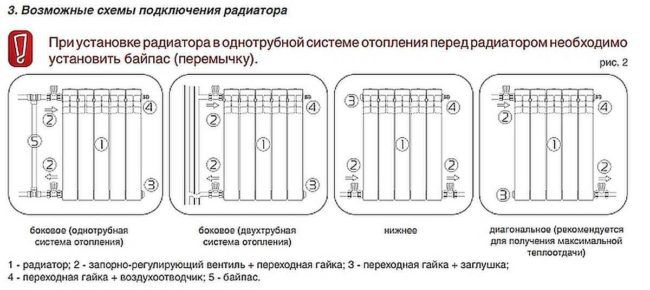

Battery Wiring Diagrams
Usually, the type of connection is selected depending on the layout and characteristics of the apartment.
Side battery connection
When the choice is made, and you have decided on the type of radiator and the type of its connection, you can start installation work.
Today, the most popular among heating devices for apartments with a central heating system are cast-iron and bimetallic batteries.
We suggest that you familiarize yourself with the instructions for each of these options, which have a number of technical features.
Before starting the installation for apartments with a central heating system, it is necessary to obtain permission from the relevant authority to carry out installation work. You will have to drain the water from the batteries, which means that you must first turn off the entire riser. This is a prerequisite, failure to comply with which can lead to a serious administrative fine. After you fill out all the documents, a locksmith will come to you at the appointed time to drain the water to the desired floor. Of course, the dismantling and installation of the batteries must be carried out during the inter-heating season.
Damage to the tightness of the heating system in an apartment during the heating season can lead to an accident, for which you will be charged an impressive fine. In addition, you will leave the whole house without heating for a long time!
Heating devices made of steel and copper alloys
Since the mass production of household appliances is focused on the manufacture of heat exchangers from ferrous metal, gas boilers with a copper heat exchanger are considered a prestigious product. Copper has high heat transfer characteristics. Therefore, small boilers with a small amount of heat carrier can be used to heat a large house. As a result, the devices are very compact.
Important! Often, buyers are interested in which heat exchanger to choose - steel or copper. You need to proceed from the physical and chemical properties of ferrous and non-ferrous metals. The specific heat capacity of copper is lower than that of steel.
That is, to heat an equal amount of substance, copper needs to transfer less heat than steel. Accordingly, the inertia of the heating system, where there is a steel heat transfer unit, is greater. The boiler automation, working with a copper heat transfer block, reacts faster to an increase in the temperature of the coolant. As a result, this leads to fuel savings. An even greater reaction of the heating system to heating occurs when the pump is running. In addition, it provides improved circulation even with disturbed pipe slopes and prevents water from boiling.
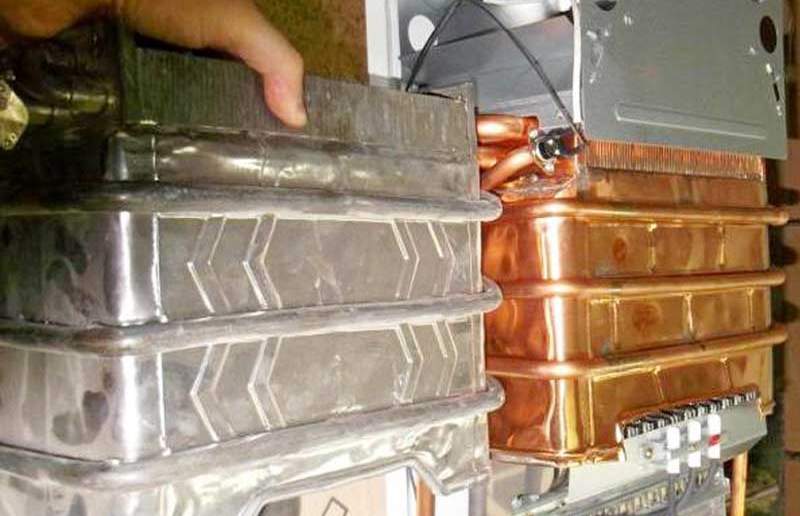

Comparing copper heat exchangers for boilers with steel, we can say that the latter are more plastic. This factor is important because there is a constant process of interaction with open fire. As a result, thermal stresses in the metal develop and cracks appear. Steel is more durable in this respect and withstands a large number of cycles: heating - cooling.
The note! The disadvantages of steel, in addition to inertia, increased specific heat capacity, include: • susceptibility to corrosion; • increased volume of the air heater surface; • a large amount of coolant; • a significant mass of heating devices.
